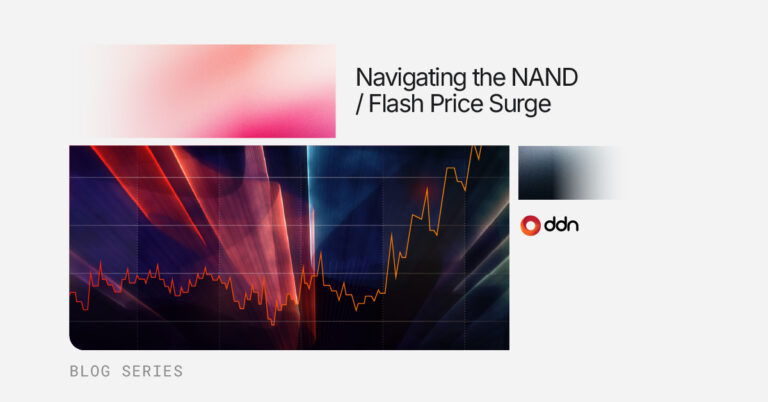Whether it’s merging onto a freeway or identifying a pedestrian crossing in low light, autonomous vehicles (AVs) rely on rapid-fire decisions based on huge volumes of sensor data. But as these systems become more complex, one truth is becoming impossible to ignore: compute alone isn’t enough. Without a data platform built for speed, autonomy hits a wall.
With the introduction of platforms like NVIDIA Drive Thor, automakers are embracing AI architectures capable of unprecedented levels of perception and inference. But Thor can only deliver if it’s fed by infrastructure fast enough to keep pace.
The AV Data Challenge: Where AI Infrastructure Breaks
Autonomous vehicle development is fundamentally a data problem. And when that data infrastructure can’t keep pace, things break in ways that directly slow down innovation and jeopardize safety.
Common Bottlenecks in AI Storage for Autonomous Vehicles:
- Lidar and sensor buffering: When ingest systems can’t stream data fast enough, perception engines miss critical frames. One AV team saw latency spikes from bursty lidar uploads cause inconsistent inference outputs leading to costly simulation failures and wasted training runs.
- Metadata fragmentation: AV datasets are only valuable if they’re searchable. Without support for rich tagging and high-speed filtering, engineering teams spend hours digging through terabytes just to isolate one rare edge case for retraining.
- GPU starvation: High-performance compute is only as good as the data feeding it. Legacy storage systems often can’t keep GPUs fully loaded, especially during checkpointing and retraining. We’ve seen fleets where 30% of GPU hours were lost to I/O bottlenecks.
These issues are the day-to-day realities for AV engineers trying to get safe, reliable autonomy into production. They slow iteration, increase cost, and directly impact time-to-market.
These problems demand infrastructure that can keep pace with AI’s scale and speed. That’s exactly what DDN’s Data Intelligence Platform was built for. That’s where DDN’s Data Intelligence Platform comes in, combining the real-time ingest power of Infinia with the high-throughput AI training muscle of EXAScaler®. Together, they eliminate the latency, fragmentation, and performance bottlenecks that stall AV innovation.
The Drive Thor Shift: Why Automotive AI Infrastructure Matters
NVIDIA’s Drive AGX Thor sets a new bar for centralized, AI-powered vehicle compute. With support for transformer-based networks, sensor fusion, and next-gen perception models, Thor is the brain of tomorrow’s software-defined vehicle.
But the more powerful the compute, the more demanding the data workload.
Thor is expected to handle tasks like:
- Real-time sensor fusion across lidar, radar, and cameras
- Vision-language modeling for scene understanding
- AV perception, planning, and control inference
- Passenger interaction, driver monitoring, and infotainment
Each of these requires instant access to massive streams of data and infrastructure that keeps up without delay or duplication.
Why Real-Time AI Storage Solutions Are Critical for AV Workloads
AV systems generate between 4 and 20TB of sensor data per day, per vehicle. Lidar, radar, and vision streams must be captured, labeled, analyzed, and used to retrain models continuously. But latency isn’t just a technical hurdle, it’s also a safety issue.
In one AV lab, delayed access to edge lidar logs meant a critical perception bug—related to a scooter rider in low light, wasn’t caught until weeks later in regression. The root cause? A data pipeline that couldn’t ingest and tag 10Gbps streams fast enough.
Another team saw its training loops stall because the storage layer couldn’t handle the 400K+ small files needed for daily model retraining. The GPUs sat idle, waiting for data that was technically “available” but operationally out of reach.
If a vehicle’s decision pipeline can’t process sensor input quickly enough, it risks making the wrong call, or making it too late. That’s why AV developers are under pressure to build data infrastructures that move as fast as their silicon can compute.
Legacy architectures that was designed for general-purpose IT or archive storage, wasn’t built for this. They’re slow to ingest, poor at managing metadata, and unable to keep GPUs fully fed. The result: wasted compute, delayed model updates, and reduced safety margins.
How DDN Eliminates Bottlenecks in Automotive AI Data Pipelines
First, real-time decision-making demands AI-optimized data processing. Traditional systems struggle to deliver the low latency required to keep up with modern AV inference cycles. Infinia addresses this directly by offering sub-millisecond latency and over 95% throughput efficiency for real-time sensor ingest. That means lidar, radar, and camera streams hit the GPU without buffering or delay, enabling safer, faster decisions when they matter most.
One OEM uses Infinia to ingest 25TB of sensor data daily from test fleets, streaming directly into GPU pipelines with sub-ms latency. Before Infinia, those ingest queues would back up during peak workloads, delaying overnight model updates.
Second, AV models aren’t static and they evolve rapidly based on incoming data from test fleets, simulation environments, and edge deployments. This continuous learning loop requires infrastructure that can keep pace. EXAScaler® delivers high-speed checkpointing and GPU-saturating throughput for model training, while Infinia ensures high-frequency ingest and intelligent metadata tagging. Together, they give developers the tools to accelerate iteration cycles and get innovations to market faster. In a recent deployment, EXAScaler® reduced model checkpointing time by 15x, enabling the AV team to run 3 additional training loops per day, shortening development timelines by weeks.
Finally, there’s the challenge of moving data from edge to core without waste or duplication. Many AV programs suffer from fragmented pipelines where edge data either sits idle or is replicated unnecessarily. Infinia solves this with metadata-triggered workflows that ensure only the right data moves upstream. Once it hits the core, EXAScaler® processes it at full bandwidth, eliminating lag and maximizing infrastructure efficiency. The result: smarter data movement, lower costs, and faster model readiness.
Not Just Real-Time. Real Data Intelligence.
Yes, fast storage is essential, but to succeed you need data infrastructure that thinks with your AI.
The key lies within moving the right data, at the right time, to the right tier of compute. That’s what Infinia does. With 600x faster object listing than AWS S3, Infinia enables real-time filtering, querying, and event-driven orchestration on multi-petabyte datasets. That’s how AV systems find the right edge cases, retrain the right models, and get smarter by the day.
At the same time, EXAScaler®’s performance at scale ensures those models are trained, validated, and ready for redeployment, without leaving GPUs waiting.
Together, Infinia and EXAScaler® offer a seamless, high-performance foundation for modern AV workloads, whether you’re training on a sovereign cloud, running simulation in Omniverse, or serving inference pipelines directly from your data lake.
Aligned with NVIDIA’s Automotive AI Vision
Everything DDN is building aligns with the direction NVIDIA is pushing in automotive:
- Thor sets the standard for consolidated AI in the car
- DRIVE AV software stack brings production-ready autonomy into the OEM pipeline
- Omniverse and simulation frameworks require massive ingest and reuse of labeled data
- AI Factories need GPU-saturating throughput and metadata-rich storage layers
In each of these cases, the question is the same: how fast can your infrastructure deliver?
From R&D to Production: Scalable AI Infrastructure Solutions
Whether you’re a global OEM running simulation pipelines at scale, or a mobility startup capturing real-world driving data for model iteration, DDN’s platform grows with your AI roadmap:
- At the edge: Infinia (2025 roadmap) will support real-time ingest and metadata tagging directly in vehicle test rigs or distributed capture points
- In the core: EXAScaler® delivers industry-leading training performance, integrated with tools like Ray, NeMo, and NVIDIA Base Command
- Across the cloud: Our platform is deployable across hyperscalers and sovereign environments, with policy-based governance to meet global compliance needs
The Future of Automotive Depends on Smarter AI Storage
To maintain a competitive edge, autonomous vehicles need smarter infrastructure. If your storage layer can’t keep pace with your inference engine, you’re not just losing performance. You’re risking safety.
DDN’s Data Intelligence Platform, powered by Infinia and EXAScaler®—is the only solution designed from the ground up to support real-time AV workflows at scale. We give AV teams what they need to move faster, iterate quicker, and bring safer, smarter vehicles to market.
To get started, speak with an expert today.


